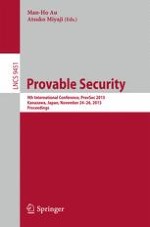2015 | OriginalPaper | Buchkapitel
Rethinking Privacy for Extended Sanitizable Signatures and a Black-Box Construction of Strongly Private Schemes
verfasst von : David Derler, Daniel Slamanig
Erschienen in: Provable Security
Aktivieren Sie unsere intelligente Suche, um passende Fachinhalte oder Patente zu finden.
Wählen Sie Textabschnitte aus um mit Künstlicher Intelligenz passenden Patente zu finden. powered by
Markieren Sie Textabschnitte, um KI-gestützt weitere passende Inhalte zu finden. powered by
